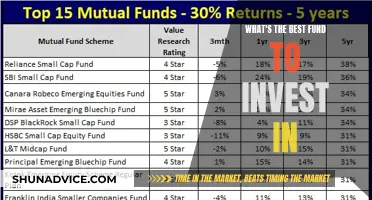
Investing in mutual funds is a great way to build a diversified portfolio without the extra cost or hassle. Mutual funds are a collection of investors' money that fund managers use to invest in stocks, bonds, and other securities. They are a practical and cost-efficient way to build a diversified portfolio of stocks, bonds, or short-term investments.
When investing in mutual funds, it is important to consider your financial goals, the type of fund that matches those goals, and the fees associated with the fund. It is also crucial to understand the different types of mutual funds available, such as stock, bond, money market, and target-date funds, and choose the one that aligns with your risk tolerance and investment objectives.
Additionally, it is essential to research the fund's performance, fees, and investment strategy before investing. By following these steps and choosing the right mutual funds, investors can benefit from a well-diversified portfolio and potentially grow their wealth over the long term.
| Characteristics | Values |
|---|---|
| Purpose | Build a diversified portfolio of stocks, bonds, or short-term investments |
| Management | Actively managed by professionals or passively indexed to a market benchmark |
| Risk | Diversification reduces risk; mutual funds are considered safer than purchasing individual stocks |
| Returns | Returns depend on fund performance, minus fees and expenses; mutual funds have historically provided high average annual returns |
| Fees | Annual fees, expense ratios, sales charges, redemption fees, and account fees may apply |
| Investment Options | Various types of mutual funds, including stock, bond, money market, index, and target-date funds |
| Investment Accounts | Individual retirement accounts (IRAs), taxable brokerage accounts, and education savings accounts are common options |
| Brokerage | Online brokerages offer a broad selection of funds; some charge transaction fees |
| Investment Style | Active funds aim to beat the market, while passive funds aim to mimic it |
| Investment Horizon | Suitable for long-term goals, but may also be used for short-term goals with caution |
| Taxes | Capital gains and dividend distributions may be taxable; tax-deferred accounts can help minimize taxes |
What You'll Learn

Understand the difference between active and passive funds
When deciding where to invest in mutual funds, it's important to understand the difference between active and passive funds.
Active funds are managed by professionals who research the market and buy and sell stocks with the goal of beating the market average. This approach requires a hands-on and active strategy, hence the name. Active funds are more flexible as managers can buy diamond in the rough stocks and are not required to hold specific stocks or bonds. They can also employ hedging strategies and quickly exit specific stocks or sectors when risks become too large. Additionally, active funds allow for tax management strategies tailored to individual investors. However, active funds usually come with higher fees as they require more transactions and incur higher salaries for analysts and fund managers.
On the other hand, passive funds are more hands-off and typically track an existing group of investments called an index, such as the S&P 500 or Dow Jones Industrial Average. Passive funds are often index funds or ETFs (exchange-traded funds) and don't require a fund manager to pick and choose investments. This approach is generally more cost-effective, with lower expense ratios, as there are fewer transactions and no fund manager salaries. Passive funds also offer good transparency as investors know exactly which stocks or bonds are included in the fund. Additionally, the buy-and-hold strategy of passive funds leads to tax efficiency, as it doesn't trigger large annual capital gains taxes. However, passive funds are limited to a specific index or set of investments and may offer smaller returns as they aim to track the market rather than beat it.
Both active and passive funds have their advantages and disadvantages, and some investors choose to blend the two strategies to take advantage of the strengths of each.
Mutual Funds: Invest Now, Here's How
You may want to see also

Calculate your investing budget
To calculate your investing budget, you should first determine your net income, which is your total salary minus taxes and employer-provided programs. Then, figure out your fixed and variable expenses for the same period.
You can use a budgeting calculator to help you understand where your money is going each month. These calculators will show you what percentage of your income you're spending or saving in each category and whether you're living within or beyond your means.
When thinking about your budget for investing in mutual funds, consider the following:
- How much do mutual funds cost? Mutual funds have minimum investment amounts, which can range from $100 to $3,000, with some funds having a $0 minimum.
- How much money do you have to comfortably invest?
- Which mutual funds should you invest in? Consider your risk tolerance and how long you plan to invest for. Generally, the closer you are to retirement age, the more conservative your investments should be.
A popular rule for budgeting is the 50/30/20 rule, which involves splitting your after-tax income into three categories: 50% for needs, 30% for wants, and 20% for savings. You can adjust these percentages to suit your personal circumstances and goals.
Remember, it's important to have a clear understanding of your income, expenses, and financial goals when creating your budget for investing in mutual funds.
UTI Midcap Fund: A Smart Investment Strategy
You may want to see also

Decide where to buy mutual funds
You need a brokerage account when investing in stocks, but you have a few options with mutual funds. If you contribute to an employer-sponsored retirement account, such as a 401(k), there’s a good chance you’re already invested in mutual funds.
You could buy directly from the company that created the fund, such as Vanguard or BlackRock, but doing so will limit your choice of funds. You can also work with a traditional financial advisor to purchase funds, but it may incur some additional fees.
Most investors opt to buy mutual funds through an online brokerage, which offers a broad selection of funds across a range of fund companies. When choosing a brokerage, you'll want to consider:
- Affordability: Mutual fund investors can face two kinds of fees: from their brokerage account (transaction fees) and from the funds themselves (expense ratios and front- and back-end “sales loads”).
- Fund choices: Workplace retirement plans may carry only a dozen or so mutual funds. You may want more variety than that. Some brokers offer hundreds, even thousands, of no-transaction-fee funds to choose from, as well as other types of funds like ETFs.
- Research and educational tools: With more choice comes the need for more thinking and research. It's vital to pick a broker that helps you learn more about a fund before investing your money.
- Ease of use: A brokerage's website or app won't be helpful if you can't make heads or tails of it. You want to understand and feel comfortable with the experience.
Mirae Asset Large Cap Fund: A Smart Investment Strategy
You may want to see also

Understand mutual fund fees
Mutual funds charge annual fees, expense ratios, or commissions, which lower their overall returns. These fees are important to understand as they can eat into your returns over time. Here is a breakdown of the common types of mutual fund fees:
- Expense ratio: This is an annual fee that covers the fund's operating expenses, including management fees, administrative costs, and marketing expenses. The expense ratio is expressed as a percentage of the fund's average net assets and is deducted from the fund's returns. Over the last 30 years, competition from index investing and exchange-traded funds (ETFs) has led to a significant reduction in expense ratios.
- Sales charges or loads: Some mutual funds charge sales fees, known as "loads", when you buy or sell shares. Front-end loads are charged when you buy shares, while back-end loads are assessed if you sell your shares before a certain date. No-load funds, on the other hand, do not charge any sales commissions.
- Redemption fees: Some mutual funds charge a redemption fee when you sell shares within a short period (usually 30 to 180 days after purchasing them). This fee is designed to discourage short-term trading in these funds for stability.
- Other account fees: Some funds or brokerage firms may charge extra fees for maintaining your account or transactions, especially if your balance falls below a certain minimum.
When investing in mutual funds, it is important to be mindful of the fees associated with them. By understanding the different types of fees and their potential impact on your returns, you can make more informed investment decisions.
Choosing Safe Mutual Funds: Strategies for Long-Term Investors
You may want to see also

Manage your mutual fund portfolio
Once you have decided on the mutual funds you want to buy, you need to think about how to manage your investment. One strategy is to rebalance your portfolio annually to keep it in line with your diversification plan. For example, if one slice of your investments has performed well and now constitutes a larger share of the pie, you might consider selling off some of the gains and investing in another slice to regain balance.
Sticking to your plan will also prevent you from chasing performance. Fund investors (and stock pickers) may want to invest in a fund after reading about its success over the last year. However, "past performance is no guarantee of future performance", and this is an investing cliché for a reason. It doesn't mean you should stay put in a fund forever, but chasing performance rarely works out.
Managing your portfolio also means managing your expectations, and different types of mutual funds should bring different expectations for returns. For example, stock mutual funds carry the highest potential rewards but also higher inherent risks, and different categories of stock mutual funds carry different risks. On the other hand, bond mutual funds, which invest in a range of bonds, provide a more stable rate of return than stock funds, and potential average returns are lower.
Money market mutual funds are fixed-income mutual funds that invest in top-quality, short-term debt and are considered one of the safest investments. They are used by investors who want to protect their retirement savings but still earn interest, potentially between 1% and 5% per year.
It's also important to understand the fees associated with mutual funds, as these will significantly affect your investment returns over time. Common mutual fund fees include expense ratios, sales charges or loads, redemption fees, and other account fees.
ISA Funds: A Guide to Smart Investing
You may want to see also
Frequently asked questions
Mutual funds are a great way to build a diversified portfolio without the extra cost or hassle of investing in individual stocks and bonds. They are professionally managed, affordable, and provide instant diversification.
The right mutual fund depends on your financial goals and risk tolerance. Consider the fund's investment strategy, performance, fees, and whether it is actively or passively managed.
Mutual funds typically charge annual fees, expense ratios, sales charges ("loads"), redemption fees, and other account fees. It's important to understand these fees as they will affect your investment returns over time.
First, decide on your investment goals and risk tolerance. Then, research and choose mutual funds that match your goals. Finally, open a brokerage account and purchase shares of the mutual funds you've selected.
Mutual funds are typically considered safer than investing in individual stocks because they provide more diversification. However, all investments carry some risk, and there is always the possibility of losing money in mutual funds.







